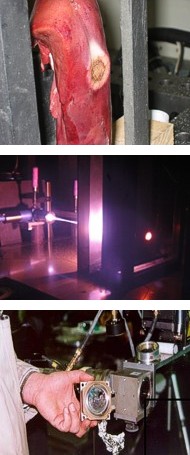 Using lasers industrially, e.g. cutting, soldering, welding or drilling of metal, dangers result from uncontrollable parallel (so-called Hot Spots) and divergent reflections of the laser beam.
Using lasers industrially, e.g. cutting, soldering, welding or drilling of metal, dangers result from uncontrollable parallel (so-called Hot Spots) and divergent reflections of the laser beam.
Results of these reflections are dangers for
- humans in the surrounding area because of burns (fig. 1: pig's liver radiated with laser)
- laser protection cabins (fig. 2: experiment with laser radiation)
- even the lens of the laser (fig. 3: lens broke in an experiment)
- safety components, control units, clamping fixtures within the laser plant
Erwin Heberer has more than 20 years of experience in research with lasers and building of laser protection plants.
Important new insights have been acquired by intensive research and have lead to changes of nominated measuring methods. Laser radiation tests were done with different types of lasers, i.e. CO2-Lasers (3 to 12 KW), Nd:YAG-Lasers (3 KW) and Femtosecond Lasers. Different focus lengths of the laser and different radiated materials were tested (metals, aluminum, single- and multiple-chamber cabins, various thick metals).



